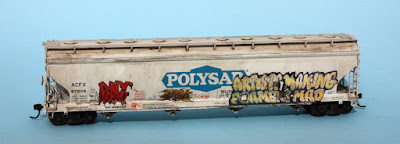I have often posted commentary about my fleet of freight cars, including detailed descriptions of how cars have been chosen for the fleet. I have also talked about the general problem of keeping track of a car fleet (for example, in this post: https://modelingthesp.blogspot.com/2013/10/evaluating-freight-car-fleet.html ) and managing its use. On my layout, this applied to scenes such as this one, with all kinds of freight cars clogging up Shumala. What is going on here? That is my topic today.
The scene above represents the transition from one operating session to another. So the sub-topic is, if you will, how is this process managed? I first began “fleet management” in the simple hope to have a rational basis for the cars operated in the fleet, for example the well-known Gilbert-Nelson idea, that freight cars everywhere essentially are present in proportion to their owning railroad’s proportion of the national car fleet (for background on this idea, you can use “Gilbert-Nelson” as the search term in the search box at right).
But I actually began record-keeping on the car fleet during the time my layout and its rolling stock were in storage, and not readily accessible. I found that hobby shop and train show visits were resulting in purchases that duplicated kits or built-up cars I already had.
So I laboriously made up a complete inventory list of all the kits that I had. I also listed where the kit was physically stored, so I could find it when needed. Then when I went places that cars might be purchased, I would print out the inventory pages to take with me. Duplication basically stopped.
Many of the kits in that initial inventory are built or gone, but I still maintain a list of what remains. Even today, it looks like this, with location in the column at far right (these are a few sample lines; you can click to enlarge):
Gradually, as various of these kits were assembled and put into service, I simply moved the entry for that kit to a separate section of the inventory, called “In Service,” and entered the date of completion of the car. Again, I tried to write enough information to fully identify the item. This section looks like the brief sample below.
And when I disposed of a kit, by sale or gift or however, I moved that entry to yet another section, for items removed from the list. It’s usually entitled something like “Gone.”
Now I realize this is quite a lot of records for a big car fleet, and indeed it was a fair amount of work when the original inventory was created, more than 15 years ago. But the various kit completions or disposals happen gradually over time, so that it only takes seconds to update a new acquisition or disposal, or placing a car in service.
I don’t describe this system because I think anyone should copy it, and certainly not because I think it’s a great system. But it’s a system. I do think some kind of record keeping like this can be of benefit to many modelers.
In addition to the foregoing, when a particular car has entered the “In Service” category, I also place a copy of its entry into my “Master Roster” of the entire fleet. I have described my Master Roster previously, as part of a description of how I set up the layout for an operating session (see this post: https://modelingthesp.blogspot.com/2017/07/waybills-part-59-more-on-op-session-set.html ).
To illustrate its contents, here’s a few lines from the current Master Roster, to serve as examples. Note that I have the storage location noted (third column) and the dates of operating sessions when the car had been used.
Again, this is quite quick to update, after an operating session. Then the next step before the next session is to pull off the cars that have completed work (delivered a load and returning empty, or set out empty, and now returning loaded), and begin to add the cars needed in the next session. (That’s the process that is underway in the top photo in this post.)
I thereby not only make sure that we don’t see the same cars, session after session, but also make use of as much of the whole fleet as I can. Whether this would appeal to other modelers, I have no idea, but it works for me.
Tony Thompson












































